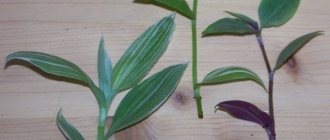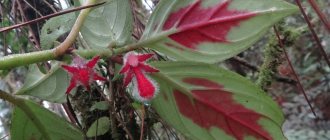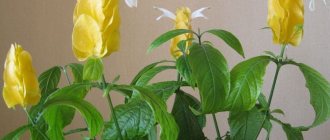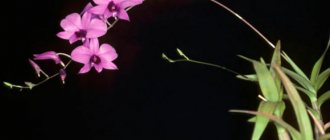Author: Elena N. https://floristics.info/ru/index.php?option=com_contact&view=contact&id=19 Category: Houseplants Published: September 13, 2018Last edits: January 11, 2021
- Diseases and their treatment
- Red Pachystachys (Pachystachys coccinea)
Pachystachys (lat. Pachystachys) is a genus of evergreen flowering plants of the Acanthaceae family, which includes about 12 species growing in subtropical and tropical regions of America and Eastern India. In indoor floriculture, the species Pachistachis yellow has been known since the 19th century, but it is still not a very frequent visitor to our windowsills. Translated, the word “pachystachys” means “thick spike” or “thick spike”: the inflorescence of these plants is a dense spike. We call pachistachis “golden candle” or “golden shrimp”.
Planting and caring for pastachis
- Flowering: from February to October.
- Lighting: bright diffused light.
- Temperature: during the active growing season - the usual temperature for a living room, during the dormant period - within 18-16 ºC. The lower temperature threshold is 10 ºC.
- Watering: during the period of active growth - regular and plentiful, during the dormant period - moderate to meager.
- Humidity: high. It is recommended to keep the plant on a tray with wet pebbles.
- Feeding: from spring to autumn - 2 times a month with complex mineral fertilizer for flowering plants in liquid form. In winter, it is enough to fertilize once every month and a half.
- Dormant period: from mid-autumn to late winter.
- Transplantation: at the end of winter: young plants - annually, adults - once every 3 years.
- Pruning: regular, at the end of the growing season.
- Reproduction: cuttings, less often – seeds.
- Diseases: root rot, as well as failure to bloom and loss of attractiveness as a result of improper care or violation of maintenance conditions.
- Pests: spider mites, mealybugs, scale insects, thrips and whiteflies.
Read more about growing pachistachis below.
Replanting and pruning
Sometimes a plant needs a transplant. This happens when it becomes crowded in an old pot (the root system has grown) or it is necessary to plant flowers from one pot in different ones.
It is best to replant pachystachys during the dormant period, when it has not yet begun to bloom, and you need to trim the shoots from below so as not to damage the flower or cause it to dry out.
The flower is removed from the pot using a special spatula, carefully so as not to damage the root system. Using slow rocking movements, holding the main stem, the plant is removed from the old soil and settled in the new one. After replanting, you need to compact the soil and water it abundantly.
Pachistachis requires special care. If you want the plant to have a lush crown without leaving the stem bare, then you should learn how to trim a flower.
In the very first year after planting, the plant needs to be pruned. When the plant reaches ten centimeters, the third pair of leaves needs to be cut off from the emerging shoots. You should do the same with the rest of the shoots that will appear later.
Pruning must be done before flowering begins. This way you will get a short but lush plant that will have up to twenty tops. After flowering, the plant can be pinched - removing leaves to form the desired crown.
Caring for pastachis at home
Growing conditions
The indoor flower pachistachis is a warm and light-loving plant; it needs bright, diffused light for normal growth and development, so the best place for a flower in an apartment is north-eastern windows. On southern window sills, pachistachis should be shaded from direct rays, at least during midday, when the sun is especially hot.
Under natural growing conditions, the lower temperature threshold for pachystachys is 10˚C, but a long stay at this temperature leads to loss of leaves, so at home the dormant period should take place at a temperature not lower than 16˚C. In summer, the pachistachis plant normally tolerates the temperature natural for our latitudes. Vacations in the fresh air - on the terrace, in the garden or on the balcony - will benefit the plant, but only if you provide it with protection from precipitation, wind and drafts.
- Aspidistra - care, photos, types
Watering and fertilizing
Pachistachis will need regular and abundant watering during the growing season (depending on the air temperature once every 3-7 days), and during the dormant period it will need moderate to scanty watering if the pachistachis spends the winter in conditions of low air temperature. If you do not have the opportunity to place the plant in a cool room for the winter, then water it as usual.
The leaves of pachystachys, which droop and droop from thirst, will tell you that it’s time to water the plant. However, it is better not to wait for such hints, but to water the soil in the pot as soon as its top layer dries.
To moisten the substrate, melt water is used, passed through a filter or left to stand for 24 hours. The water temperature for irrigation should be 1-2 degrees warmer than in the room.
Tips for growing aphelandra on a windowsill
Caring for pastachis at home involves the application of fertilizers. Pachistachis is fed during the period of active growth 2 times a month with complex mineral fertilizer, which is applied in the form of a solution to a pre-moistened substrate. You can fertilize pachistachis with organic matter, for example, a solution of mullein or chicken manure, which is sold in specialized stores in ready-to-use form. If pachistachis does not rest in winter, feed it with a mineral complex once every 1-1.5 months.
In the photo: Growing pachistachis at home
Transfer
Young pachistachis are replanted annually in the spring, before flowering begins. For adult plants, the pot should be changed no more than once every three years. For pachistachis, you need an earthen mixture of equal parts of peat, leaf soil, humus, turf soil and coarse river sand. The soil should be disinfected two weeks before replanting by heating it in the oven or spilling it with a strong solution of potassium permanganate. You must first lay a layer of drainage material at the bottom of the new pot, and the flower should be trimmed before replanting. Pachistachis prepared for transplantation is transferred from the old pot to a new one, after which the voids are filled with soil mixture, the substrate is compacted and watered. The plant should be protected from the sun for several days after transplantation.
How to grow crossandra on a windowsill
Trimming
The flower is trimmed regularly, otherwise it will become unattractive due to the shoots exposed at the bottom. When and how to prune pachistachis? At the end of the dormant period, the shoots of the plant are cut off, leaving only 10-15 cm. The cuttings can be used as cuttings for propagation.
- Indoor rhododendron (names and photos)
Pachistachis flowering
Pachistachis blooms from February to October. You can, of course, make it bloom in winter, but this will require additional lighting. The funny spikes of Pachistachys resemble the inflorescences of Aphelandra, which is not surprising, only in Pachistachys they are more elongated. The inflorescences are attracted by yellow bracts that do not fade for several weeks. And the flowers themselves - spongy, light, almost white - fall off very quickly, after 3-4 days.
Problems with flowering can only occur if the plant does not have enough light. Old, elongated and bald pachistachys in the lower part of the shoots form a small number of inflorescences, and flowers form only on young shoots, so if you want to get more inflorescences, force the plant to branch.
Pachistachis begins flowering at an early age: in some cases, cuttings bloomed within a couple of months after rooting.
New ones branch off from wilted pachystachys inflorescences, so flowering can last quite a long time. Still, it is advisable to remove faded spikelets for preventive and hygienic purposes.
Care in spring and summer
Transplantation and transhipment
To preserve the decorative properties of pachistachis and constant flowering, it is replanted once a year. This is done in the spring, before the plant begins to produce new shoots.
When replanting, you should not significantly increase the volume of the pot; the main goal is to change the soil to a new, more nutritious one.
There are 3 ways to replace soil:
- replanting with freeing the roots from the old soil;
- transshipment with preservation of an old clod of earth with roots;
- replacing the top layer (when the plant is very large and in a large pot, you can loosen only part of the soil 5–10 cm deep and replace it with new soil).
How to replant a plant and carry out transshipment
- Choose a new pot; its diameter should be 3–5 cm larger than the diameter of the old one.
- Rinse the container with running water and let dry overnight.
- Place drainage at the bottom of the pot. When replanting, fill it with soil so that a small hill is formed in the center.
- An hour before the procedure, lightly moisten the soil in the old pot with the plant with settled water.
- If the size of the container with pastachis allows, then tip the pot with the plant onto your hand and, passing the stems between your fingers, with a slight shake, remove the lump of earth with the flower, placing it horizontally.
This is the best way to remove a plant from an old pot:
If pachystachys has reached a large size and grows in a large pot, use a knife to loosen the soil near the wall of the pot, carefully place the container on its side and slowly remove the plant with a lump of earth, trying not to disturb the roots. When replanting, you will need to free the root system from the old soil. When transshipping, you should save a lump of earth with roots.
- Carefully inspect the root system for the presence of old, dried or rotten roots and remove them.
- When replanting: carefully spread the roots over the poured soil in the new pot. When transshipping: place the old earthen ball with roots in the prepared container. Then add the required amount of new soil. Its level should be 1–2 cm below the edge of the pot so that when watering, water does not flow out over the edge.
- Water the transplanted plant with settled water.
As you add new soil, it is recommended to compact it lightly.
Table: comparison of clay and plastic pots
| Pot type | Advantages | Flaws |
| Clay | Heavy in weight, making it more difficult to tip over | Easily breaks |
| It has a porous structure, so the plant breathes better | The soil dries out faster than in plastic pots | |
| The soil in such a container rarely sours even when it is waterlogged. | Pores become clogged over time and cannot be washed out. | |
| More expensive than a plastic pot | ||
| Plastic | Lightweight and almost unbreakable when dropped | In summer the pot heats up quickly |
| Retains moisture well | The soil in such a container may turn sour if over-moistened. | |
| Wide selection of shapes and colors of similar containers | ||
| It's inexpensive |
Reproduction of Pachistachis
Most often, the vegetative method of propagation of pachistachis is used - cuttings. As we have already written, shoots cut during spring pruning can be used as cuttings. How to propagate Pachistachis?
You will need apical cuttings with two internodes and two pairs of leaves. For rooting, which takes place most successfully at a temperature of 22˚C, the cuttings are placed cut side down in a container of water. During the process of root growth, leaves may fall off the cuttings, and to prevent this from happening, the leaf blades should be shortened by half. But even if in this case the leaves fall off, do not despair: after planting in the ground, new leaves will appear at the top of the cuttings.
In the photo: Pachistachis flowering
Cuttings are also rooted in a loose substrate of equal parts of leaf soil, humus, peat, turf soil and perlite. A plastic bottle cut off at the top is filled with the soil mixture, and the cut of the planted cuttings is treated with Kornevin before planting in the bottle with the substrate. To create a greenhouse effect, the top of the bottle with the cutting is covered with a film, which is removed from time to time so that the cutting can breathe. Or you can put the upper part of the bottle in which the cutting is planted on the lower part of the bottle and secure it with tape, and for ventilation simply unscrew and remove the cap. Keep the cuttings under bright diffused light.
- Caring for Citrus Plants
There are usually no problems with the rooting of Pachistachis: the roots grow even in cuttings that have lost leaves. When the cuttings acquire a root system, plant 3-4 of them in a low and wide pot: in the form of a bush, pachistachis looks much more attractive. And don't forget to pinch the tops of the stems from time to time.
Reproduction
Propagation of the southern plant can be done in two ways: cuttings and seeds. The first one is considered easier and more accessible, so we’ll talk about it first.
- Cuttings
Pachistachis propagation by cuttings
Before you start cuttings, prepare the soil. It is best to fertilize it with manure or humus so that the plant takes root immediately and produces bright fruits, but almost any soil is suitable for pachistachys. Then, use a sharp knife to cut off the longest shoots from the plant and place them in water. The shoots must be kept in water until roots appear. When this happens, the shoots can be planted in a pot in prepared soil. It is best to plant up to four cuttings in one container to make the bush more lush.
This type of reproduction is considered the most accessible, and also safer. You can be sure that pachystachys will retain its shape, inflorescence color and length. In addition, with such cuttings, the flower retains its maternal properties. A more risky method is propagation by seeds.
- Seeds
Propagation by seeds is not always possible at home; moreover, this is a rather painstaking method. The purchased seeds are sown in loose, breathable soil and covered with film, creating a greenhouse effect. The film should be opened once a day for spraying and a little ventilation. When the first shoots appear, the film is removed so that the pachistachis gets used to normal conditions. And after three or four pairs of leaves appear, the flower settles into place.
Read in more detail: Propagation of indoor plants is an amazing activity
Pests and diseases
Diseases and their treatment
When growing pachystachys in heavy soil, abundant and frequent watering can lead to stagnation of water in the roots and damage the plant to root rot. Inspect the root system of Pachistachis, and if it is not completely rotten, remove the affected areas, keep the roots in a fungicide solution and plant the plant in a fresh, more suitable substrate. However, it is not always possible to save a plant from this fungal disease, even if you reduce watering and at first use a fungicidal solution to moisten the substrate.
To prevent root rot from developing, monitor the condition of the substrate in the pot: it should be loose and light. And be sure to drain the water that leaks into the pan after watering.
If you are keeping a pot of pastachis on a tray of wet pebbles, position it so that the pot's drainage holes are not submerged in water. Water should saturate the substrate with moisture, and not stagnate in it.
In the photo: How to grow pachistachis
All other troubles arise in pachistachis from improper care or as a result of non-compliance with the conditions for its cultivation.
- For example, if a flower's leaves have fallen off, this is evidence that you did not water it enough or kept it in a draft.
- Curled leaves and dry tips are a sign of too low air humidity in the room.
- Strongly elongated stems, lack of flowering and small leaves indicate that pachistachis suffers from a lack of light.
- Slow development and stunted growth mean that it is time to change the substrate in the pot, and shoots exposed at the bottom hint that the pachistachis requires rejuvenation - short pruning.
Pests and their control
Most often, indoor pachistachis is affected by mealybugs, scale insects and spider mites. All of them feed on the cell sap of the plant. If you notice white cotton-like lumps in the leaf axils or small yellow dots on the leaf blades, take action immediately. Scale insects and scale insects should be removed from the plant with a cotton swab dipped in alcohol. Mites are not so easy to detect due to their small size, but a sign of their presence, in addition to pinpoint bites on the leaves, is a thin web. Wash the pachistachis in the shower, protecting the substrate from soapy water, then let the plant dry and treat the leaves with Actellik or Fitoverm. It is better to spray pachistachis outdoors.
Occasionally, Pachistachis is occupied by whiteflies and thrips, which also feed on cell sap. Measures to combat these pests are the same as for ticks, scale insects and scale insects.
Possible problems and difficulties
Pachistachis is a capricious flower, so some owners of an exotic plant may encounter various difficulties, which, however, are not so difficult to solve.
- Often, pachistachis leaves begin to curl, which greatly worries the owners. This happens for two reasons: too dry air or poor watering of the plant. If there are no mechanical damage or pests on the inside of the leaves, then increase the amount of moisture and spray the leaves with a spray bottle once a day. If the leaves curl and their tips become dry, this is a consequence of improper soil care.
- Sometimes the leaves of the plant fall off. This can happen due to overheating or, conversely, a draft. Check whether your flower lives in comfortable conditions; if external conditions are in order, then it is worth adding mineral fertilizers to the soil.
- If the lower part of the trunk is exposed, then the plant requires replanting or pruning. Once every two years it is recommended to renew the pachystachys to maintain its shape and increase the number of inflorescences.
- Owners of a young flower sometimes wonder why pachistachis does not bloom? Most often this happens due to insufficient lighting. If it's June and your pet is ready to bloom, but the yellow inflorescences are not appearing, then try to find a brighter place for it.
Diseases can also affect pachistachis. Whiteflies, aphids, spider mites or mealybugs appear on flowers. The best way to combat such pests is with special preparations that can be purchased at any specialty store. And the prevention of such diseases is carried out with the help of ventilation (in the summer) and loosening the soil.
Read more: Pests of indoor plants and ways to combat them
Pachistachis is a beautiful and bright flower that will decorate any home. There are no special signs or superstitions associated with it, but yellow has long been considered the color of wealth, happiness and strength. Such a resident will delight owners and guests, warming them with his bright appearance.
Types and varieties
a description of the most commonly grown home-grown yellow pachystachys (Pachystachys lutea) at the beginning of the article, but sometimes two more species can be found in indoor and greenhouse culture:
Red Pachystachys (Pachystachys coccinea)
Mainly a greenhouse plant, since this species reaches a height of 2 m. Its bright green, sometimes covered with burgundy streaks, leaves up to 40 cm long are located on short petioles. The bracts are also green, and the elongated tubular red flowers look like the feathers that were once used to decorate hats. Because of the flowers, this species is called "Cardinal's Guard".
In the photo: Red Pachystachys (Pachystachys coccinea)
Pachystachys spicata
A species that is grown mainly in botanical gardens and is a rare representative of the genus in home collections. It has dark green leaves up to 25 cm in length and bright red flowers collected on a cone-shaped bract. Some experts consider Pachistachis spicata not an independent species, but a variety of Pachistachys red, but there is still no clarity on this issue.
In the photo: Pachystachys spicata
Description
This amazing flower came to Russia from South America - there it grows freely on the street, just as, for example, daffodils grow here. Unfortunately, the climate of central Russia is not conducive for Pachistachis to fill our forests and fields, but with good care it may well become a full-fledged inhabitant of your room, delighting both owners and guests with its bright colors.
Pachistachis in the garden
Typically, pachistachis grows up to two meters in height, so you should not place it on a closet - the freedom-loving plant will not tolerate such treatment. But now, thanks to agricultural technology, there are smaller specimens that will sit comfortably on the windowsill. Pachistachis leaves are elongated, pointed at the ends, the leaf length reaches ten centimeters. The inflorescences form a spike somewhat reminiscent of a candle (the similarity increases if the flower is yellow); over time, white petals resembling wings or feathers appear along the edges of the inflorescences. At this moment, Pachistachis looks like an exotic bird from the tropics.
The most common color of the plant is yellow and is grown at home. In warmer regions, yellow pachistachis is called golden candle or golden shrimp. The flowering of this pachistachis is quite long - from June to autumn, for this it is appreciated by lovers of indoor plants, because not every flower will delight with its buds for more than one month.
Pachistachis yellow
Pachistachis red
Another type of tropical plant is Pachistachys red. He rarely becomes a permanent resident of city apartments, as he is more whimsical and capricious, requiring more careful care and high temperatures. This species is most often grown in greenhouses. The bright scarlet shade of the inflorescences and dark olive leaves remind us that this exotic guest arrived from hot countries.
Pakhistakhis - signs and superstitions
Pachistachis is credited with magical properties: it fills the house with vitality, has a beneficial effect on the human nervous system, that is, it has a calming effect on hyperactive people and at the same time activates passive household members. The yellow color of the bracts of pachystachys leaves has a positive effect on the relationship between spouses, helping to smooth out conflicts and develop compromise solutions.
Some signs are also associated with pastachis. For example, if, with normal care, the plant’s inflorescences suddenly begin to fall off and the leaves dry out, this portends troubles with or among relatives. But the unexpectedly bright color of the bract leaves is a sign of an approaching pleasant event. Pachistachis presented as a gift is a wish for happiness in your personal life, which, they say, always comes true.
Diseases and pests
Mature shrubs, as a rule, are not prone to disease. The main problems arise from improper care. Let's talk in more detail about how to act in each situation.
Why do the leaves curl?
Curling and falling leaves can most often be seen during the cold season. The main reason is uncomfortable living conditions. Most often these are drafts, as well as temperature changes .
The second reason is too much water in the soil.
Do not forget to drain excess water from the pan, do not allow moisture to stagnate in the roots - it can have a detrimental effect on the well-being of the flower.
Why doesn't it bloom?
It also happens that the bush does not form flower stalks. This is due to two factors:
- lack of spring pruning;
- the plant does not have enough light.
Getting a healthy, flowering shrub is not difficult - it is only important to eliminate the listed reasons in time and pay maximum attention to the flower.
Leaves turn yellow and fall off
Yellowing and subsequent falling of the foliage indicates non-compliance with the recommended temperature regime .
Remember that too high a temperature leads to plant diseases. In winter it should not rise above 16-18 degrees. A pot with a plant can be placed on a closed loggia.
The leaves turn pale and wither
This condition is due to three reasons:
- Excess sunlight.
- Rare watering.
- Lack of nutrients in the soil.
The bush stretches out
When the stem of a bush grows strongly and it loses its beauty, take care of proper lighting . Move the pot to a brighter place, and then use pinches to give the flower the desired shape.
During this period, the plant will need abundant watering.
Pachystachys transplant
It is advisable to replant small, rapidly growing pastachis every year, carefully removing the root system along with soil and transferring the lump to a new pot. The best time to transplant pachistachis is the last month of winter, after the plant is pruned.
Indoor culture is not too whimsical. When choosing soil for pachistachis, you should give preference to loose, moderately nutritious mixtures that allow air and moisture to pass through well.
Ready-made substrates for ornamental flower plants are perfect for pachistachis. But you can make your own soil mixture.
To do this take:
- 2 parts of turf land;
- 1 part peat cleared of coarse inclusions;
- 1 part leaf humus;
- 1 part sand.
A handful of vermiculite or crushed sphagnum will help to loosen and structure the mixture. To plant rooted cuttings, charcoal is added to the substrate. This component, like moss, helps not only to enrich the soil, but also to protect plants from fungal diseases of pachystachys, pests and rots that can affect a flower at high humidity.
Another useful additive - crushed coniferous tree bark acidifies the soil, which the plant needs for good growth and flowering.
When an adult flower is replanted, there is no need to clean the roots from the remaining substrate. It is enough to carefully remove dead areas of roots and hard lumps of depleted soil that interfere with the filling of the new mixture. Under large specimens that are difficult to replant, in the spring the top layer of soil is carefully changed, and a new loose substrate is poured on top to the previous level.
Pakhistachis – photo
The beauty of pachistachis is still unusual for many gardeners. So we invite you to admire it in our gallery and form your own opinion!
Photo: dom-florista.ru
Photo: rastenievod.com
Photo: commons.m.wikimedia.org
Photo: ru-pole.ru
Photo: greeninfo.ru
Photo: pinterest.ru
Photo: siteandlife.com
Photo: dontrava.ru
Photo: domashniecvety.ru
Photo: flo.discus-club.ru
Photo: zen.yandex.ru
Photo: sornyakov.net
Photo: latin-wife.com
Photo: 6cotok.boltai.com
Photo: richardlyonsnursery.com
Photo: flowertimes.ru
Photo: rastenievod.com
Photo: bskod.ru
Photo: sushi-empire.ru
Photo: youla.ru
Photo: forum.bestflowers.ru
Photo: oir.mobi
Photo: zen.yandex.kz
Photo: forum.bestflowers.ru
Did you like the post? Subscribe to our channel in Yandex.Zen, it really helps us in our development!
Possible difficulties
Errors in care and flower discomfort may be indicated by the following signs:
- Curling leaves - the room is too cold, there is a draft or watering is too abundant.
- Lack of flowering - lack of light or neglect of the spring pruning procedure.
- In winter, the leaves change their color to yellow and fall off - the temperature in the room is too high. During the cold season, it is advisable to keep the room at no more than 16-18 degrees.
- Withering and pale leaves - lack of nutrients, too bright lighting or poor and infrequent watering. In this case, it is recommended to move the flower out of the bright sun, fertilize it with complex mineral fertilizers and adjust the watering regime.
- Stretching of branches - the plant does not have enough light. The flower is moved closer to the window or special lamps are installed; it is also necessary to correct the shape of the bush by pruning.
Bathonic description and homeland of the plant
Pachistachys was brought to Europe by travelers from the tropical forests of America. Under natural conditions, the flower can also be found in eastern India and in the coastal forests of Australia. The exotic plant is a representative of the Acanthus family; in its genus, according to various sources, there are from 12 to 17 species of perennial evergreen shrubs up to 1-2 meters in height.
Pachistachis is a lush bush with branched erect stems, on which rather large dark green leaves are attached oppositely. They are oval in shape with a pointed tip, and their length reaches 12 cm. Clearly visible veins give the leaves a special decorative appearance, making the leaf plate look slightly ribbed.
The plant received its name, which means “thick ear,” due to the shape of the spike-shaped inflorescences. Interestingly, they are nothing more than bracts consisting of many sepals, which are most often colored yellow-orange. In appearance, the inflorescences resemble curly pointed candles about 12 cm high.
During the flowering period, white or red tubular flowers bloom from the bracts of Pachistachys. They are short-lived and fall off fairly quickly. However, the ear itself stays on the bush for a very long time, giving the plant a bright decorative appearance throughout the entire flowering period - from spring to autumn. Sometimes you can count up to 20 bright golden “candles” on a plant.
In warm countries with tropical and subtropical climates, where pachistachis is especially popular, it is widely used in landscaping gardens and parks as a flowering perennial shrub. Local flower growers affectionately call it “golden candle” and “golden shrimp”. In central Russia, pachistachis can be found in garden plots, where it lives as an annual crop. But most of all, it is loved by Russians as a houseplant, which has been decorating the home interior with its exquisite appearance for many years.
Pachistachis yellow
Flower growers most often purchase this type of plant to decorate their home. It is an evergreen upright shrub, the height of which can reach 100–120 cm. The stems in the upper part of the plant are covered with thin dark green bark, and in the lower part they become lignified. The emerald shiny leaves of Pachistachis have an oval, elongated shape, narrowing towards the base. Their width is about 5-6 cm, and their length varies from 15 to 20 cm. The leaves are arranged crosswise, opposite.
During the flowering period, namely from the beginning of summer to the beginning of autumn, large flowers 10-15 cm long, reminiscent of a spike, bloom on Pachistachis yellow. Over time, white, cream or slightly yellowish tubular-shaped flowers bloom from each bract located on the spike. Their diameter is only 5 cm.
This is a fairly unpretentious type of plant. However, it requires abundant watering and frequent spraying in the hot season. If aphids, mealybugs or whiteflies appear on the trunk and leaves of the plant, pachistachis should be treated with the usual protective agent.
Features of care for Pachistachis flowering
On young growth, foliage and bright inflorescences in the form of yellow or red candles actively appear. However, even after pruning, the gardener may not receive the desired flowering. This happens if:
- the flower grows in a pot that is too spacious, and such freedom for the root system results in the growth of the crown and the absence of flowers;
- the plant experiences a nutritional deficiency, which is especially noticeable in young, actively growing specimens.
Therefore, when planting and replanting pachistachis, they are very careful in choosing a pot, and then regularly feed the plant.
Planting Pachistachis
Young specimens must be planted in a substrate intended for ornamental and flowering crops. Place a good drainage layer of pebbles or expanded clay at the bottom of the container.
You can also prepare the soil yourself. This is done from peat, humus, sand, clay and leaf soil. All components should be taken in equal proportions .
To accelerate growth during the growing season, it is recommended to feed the flower with special preparations.
Choosing a pot
For young plants, you should buy small containers. Large specimens are transplanted into spacious flowerpots. This way the root system will develop well .
When carrying out the procedure, only the “transshipment” method should be used . The soil around the root system is not removed. The roots are cleaned only when there are visible reasons for this. These include the presence of root rot or waterlogged soil.
Advice! Containers for pachistachis need to be purchased so that their depth and diameter are the same.
How to cut pachistachis
Cuttings are one of the simple and effective methods of propagation . You can separate planting material throughout the year.
Before rooting the cuttings, you should prepare a place in the mini-greenhouse. In this case, the air temperature should be about +200C. After roots appear on the cuttings, you can move them into the substrate.











